(The Study of Threes)
http://threesology.org
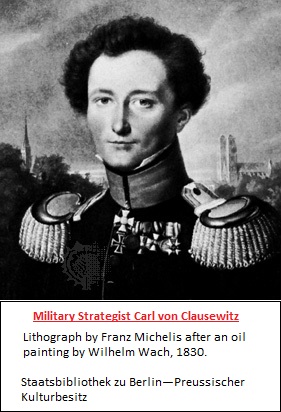
Upon my initial receipt of the article entitled "TIP-TOE THROUGH THE TRINITY" (The strange persistence of Trinitarian Warfare) concerning the Clausewitzian Theory on military strategy, I sporadically glanced at the first image and underlying introduction and came away with the impression that it was a theoretical position being used by those involved in some interactive gaming interest. Though I was wrong in this presumption, I readily charge to my defense by saying that I was preoccupied at the time with some other research and so did not give the information any further interest until several weeks later when I found myself with a moment's respite from other pursuits. However, even though an extended reading piqued my curiosity and began the initiation of thoughts for writing a review, my energies were once again directed along another area, albeit directed towards an analysis involving sociology and governing schematics. Nonetheless, I shared my thoughts at the time with a Colleague:
I have also begun thinking about writing a page on that which you sent me, since it appears the author's review does not adequately address the three-patterned format. It has led me to think about how triplicity is being used to describe the philosophy of warfare. My first impressions are that the metaphor is being used very simplistically because the author has a limited sense of the threes phenomena ideology which we are pursuing. I will have to give it some more thought. (Dec. 5th, 2015)
I am glad I was distracted from the previous course of addressing the contents because it would have led me towards a mere reiteration of various patterns-of-three in other subject areas that are not mentioned in the article. In other words, the content needs to be addressed from a much larger philosophical consideration that does not provoke the situation of argumentative semantics related to interpretation and internalized associated values with one concept or another such as what is being meant by an authored word as opposed to various interpretations based on different meanings thereof. For example, a bit of time was laid out for discussing the meaning of the word "politik" as meant by the author as opposed to the accumulation of ideas following someone's interpretation thereof which may be different from what was intended... that is if the original author actually knew how they were using the word... whether in a general or specific sense per sentence, paragraph or illustrated idea. In short, it is of need to address the difference between the usage of tripartite issues attendant with Clausewitzian Triplistic theory, from the perspective of it as an issue of language and cognitive development; as opposed to the consideration that War can be treated as a definitive type of strategy in and of itself, regardless of known and unknown variables... like a game of chess whose moves and counter-moves can be known before hand like a computer program initiated in the context of being a contest that may be arranged to beat any opponent... yet the three directions of horizontal, diagonal and vertical are overlooked as an underlying schematic of how the game is rigged.
The rigging of the game by defining three spatial directions is like stacking a deck of cards with three face cards, or using three cups to hide a single marble; or using three branches in a government so as to principally minimize or exclude the variable existing with the admission of letting the populace be part of the Checks and Balances formula with their own legislative branch, by way of a Cenocracy (New Government). In other words, if one adopts the strategy of Clausewitzian theory as a set of standardized game rules, that all must abide by, then the game is fixed because it can be fixed by not permitting extraneous variables to be used for consideration. In this way, all forms of government are fixed, just like all gaming interests which are designed as a business to make money for the House, or owners. Regardless if someone abides by the set rules, the game is fixed... and may be called a fixation for those who abide by the rules without questioned obedience, along with a deference to authority who are left to decide whether or not a rule has been broken. All governments, religions and business strategies (i.e. "games") are fixed. You can be in a position which benefits you, hurts you, or generally allows you some measure of participation as an observer... like most betting, voting, and selective shopping does.
"Rigging the system" and denoting the system of rigging with an authoritative title so as to disguise the underlying model can be seen in the usage of "syllogisms", that I refer to as "silly"-gisms because they are a type of intellectual game with a set of rules to be used in order to derive an expected result. A "syllogism" is defined as "deductive reasoning" and "logical" with the "answer" being derived from two premises, with the three words (deductive/reasoning/logical) meant to convey some purported level of higher intelligence to be garnered from a three-patterned schema. It is a simplistic crossword puzzle, so to speak, that might be more easily seen with the use of an example:
Silly-gisms are multi-labeled:
- Thesis ~ Antithesis ~ Synthesis
- Indulgence ~ "Middle Way" ~ Asceticism
- Major Premise ~ Minor Premise ~ Conclusion
- Contradiction ~ Excluded Middle ~ Identity Principal
Silly-gisms can also be portrayed with geometric or linear forms, and supported with other mediums such as food, drink, music, etc... The Christian Trinity is a silly-gism made into a very elaborate ideology, as are many three-patterned perspectives. Many of us engage in such an exercise, because it is part of who and what we are.
Discussing the internalized elements of the Triplistic Clausewitzian Theory gets one involved as a participant in the discussion as it is framed in context with those ideas thought to be most relevant to the particularities of a given topic pursued in any given moment. By diving into the discussion as it is laid out, one becomes an immersed gamester of this Triplistic line of Theorizing. I am not at the present interested in engaging in such pugilistic sparring, because there is an item that needs to be introduced for discussion which involves all formulas of triple-based orientations, regardless of subject. This issue is related to language and how language can both develop and transform thought in what some may want to describe as a situational response that varying words might well be used to describe the association, such as symbiosis, relationship, adaptation, reflex, mutation, epiphenomenon, vibration, etc...
In order to understand the fundamental scaffolding of any Triplistic theory, we need to acknowledge developmental parameters. Our human physiology subjected to given environmental circumstances can dramatically (or subtly) influence of a theory's basic structural pattern, be it of a single, dual, triple or whatever formula. For example, someone subjected to a social environment in which a trinitarian religious view is both prominent and repetitive— may well be influenced to adopt a similar perspective, or even the same pattern offered in an antagonistic or rebellious manner. Nonetheless, the "three" structure is retained. Yet, though we can point out the influence for such three-patterned uses, how is it that the first usage arose, in whatever model and context, and why is the "three" being used in so many different ways, when there are various other patterns available; and whether or not a person is aware of such?
Despite all the rationalizations one might want to resort to in describing the value of using a "three" organizational formula in Clausewitzian theory, such that it is a basic formula that lends itself well to many different human interactions; such comments remain as superficial reasons even if presented with the most artfully embellished linguistic applications. Just because something is presented by so-called important or authoritative people, in a serious context, with language frequently found amongst the expressions used by those with above-average I.Q.s, does not change the fact that they may have no idea whatsoever why they are using the pattern. However, instead of trying to understand the origin, people are engaging in tripartite-laced views in a parroting fashion... and like a bird-brained parrot, have little sense of reality beyond their vocalized considerations. In other words, their presumably understood basis for utilizing a particular pattern is superficial. Metaphorically speaking, while they can acknowledge the presence of the forest if pointed out, they get lost in it and take its presence for granted as an environmental circumstance affecting their perspective. Because such is the case for those discussing different theories involving tripartite formulas, the usage of such needs to be reexamined in order that it may help them to improve upon their ideas.
Our language usage is guided by our mechanism of hearing. Our mechanism of hearing is an adaptation to environmental conditions which framed the direction along which our physiology has been molded. These environmental conditions are changing and will thus continue to influence our physiology which will thus continue to affect our patterns of thought. Let us look at our hearing and recognize the existence of a recurring tripartite pattern:
| 3 overall
divisions: Outer - Middle - Inner 3 middle ear divisions: Tympanum - Epitympanum - Mastoid antrum 3 eardrum membranes: Cutaneum - Collagen fibers - Mucosm 3 semi-circular canals 3 bones (ossicular chain): Incus - Stapes - Malleus 3 main malleus ligaments: Anterior- Lateral -Superior 3 incus anchorage points: Malleus - Stapes - Bony fossa wall 3 cochlea sections (Scala): Vestibuli- Tympani -Cochlear duct 3 extrinsic muscles (Auricularis): Anterior- Superior - Posterior 3 sound conduction paths: Elec. - Mech. - Fluid Bone (solid) - Air (gas) - Fluid (liquid) 3 nerve stimulation paths: Mech.- Chem. - Elect. 3 outer hair cell rows (typical in mammals) |
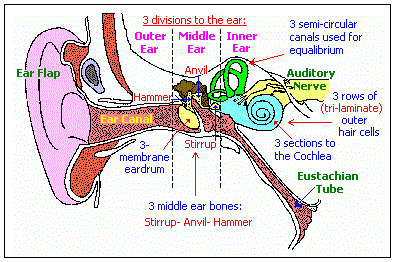 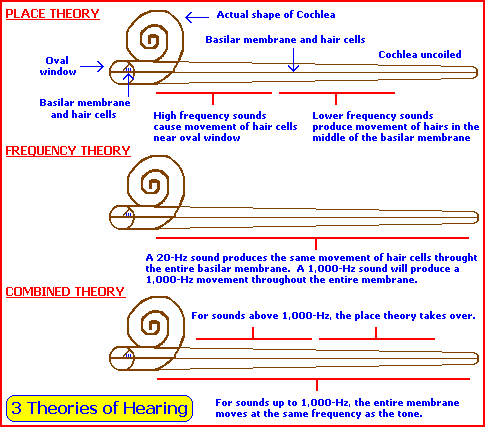 |
At this point, let us try to imagine our language development if our ear components exhibited a different predominant pattern: 2, 4, 5, 6, 7, 8, 9, etc...
3 main forms of ossicular chain fixation: Fluid - Mechanical -Otosclerosis
3 classes of ossicular lever action: Force arm - Resistance arm - Fulcrum
3 principal types of deafness: Conduction - Nerve - Stimulation
3 acoustic distortion forms: Frequency - Phase - Amplitude
3 basic properties of vibrating bodies: Inertia - Elasticity - Dissipation
3 sound characteristics: Pitch - Volume (intensity) - Tone
3 Sound wave propagation processes: Diffraction - Transmission - Reflection
3 turns to the Cochlea, variously mismeasured as 2 3/8, 2 1/4, 2 5/8, 2 1/2, 2 3/4, 2 7/8, etc., ???
Stark & Nathanson (1973) differentiated three types of infant vocalizations:
- Cry sounds (sounds produced in acute stress such as pain or hunger)
- Discomfort sounds (a lesser degree of discomfort such as when not reaching a toy)
- Vegetative sounds (coughs, burps, sneezes)
Wolff (1965) described three cry types:
- Basic cry
- Mad/Angry cry
- Pain cry
Truby & Lind (1965) referred to three acoustic types of cry:
- Phonation (basic cry)
- Dysphonation (turbulence)
- Hyperphonation (shift)
3 successive/overlapping stages of infant babbling (examples):
- Single Chunks (Ba)
- Double chunks (MaMa)
- Triple Chunks (DaDaDa)
(combinations produce long strings of "reduplications")
3 successive/overlapping stages of word development (examples):
- Single word (Doggie)
- Double word (Doggie Come)
- Triple word (Doggie Come Here)
(combinations can produce yakety-yak-yak)
3 Esophagus parts: Pars Cervicalis - Pars Thoracica - Pars Abdominalis
3 single and 3 pairs of cartilage compose the frame (skeleton) of the larynx
3 basic parts to all languages: Subject - Object - Verb
3-model structure of all languages: Phonology - Grammar - Lexicon
3 parts to speech: Consonants - Vowels - Supra-segmentals
3 stress forms in language: Primary - Secondary - Weak
3 English Language divisions: Old - Middle - Modern
3 Archaic Chinese Language divisions: Early - Middle - Late
3 sentence Ends: Period - Question Mark - Exclamation Point
3 sentence Types: Simple - Compound - Complex
3 library researches: Author - Title - Subject
3-part mnemonic rule: I before E except after C
3 Noun types: Person - Place - Thing
3 Pronoun types: First person - Second person - Third person
3 Personal Pronoun Cases: Subjective - Objective - Possessive
3 Personal Pronoun Genders: Masculine - Feminine - Neuter
3 Verb Moods: Indicative - Imperative - Subjunctive
3 Verb Inflections: Tense - Mood - Number
3 Adjective comparison degrees: Positive - Comparative - Superlative
3 Affix subdivisions: Prefixes - Infixes - Suffixes
3 basic correct punctuation units: Phrase - Independent Clause - Dependent Clause
3 word variation categories: Antonyms - Homonyms - Synonyms
3 types of Verbals (special forms of a verb):Gerund - Infinitive - Participle
3 successive stages of writing development: Logography - Syllabography - Alphabetography
3 great writing steps: Sumerian phonetization - West Semitic syllabary - Greek alphabet
3 writing systems on Rosetta Stone: Hieroglyphics - Demotic Script - Greek
3 languages on Bihistun Rock: Old Persian, Akkadian (or Babylonian) and Elamite
3 languages on the Galle stone tablet inscription: Chinese, Tamil and Persian
3 Mayan Codices: Dresden Codex - Madrid Codex - Paris Codex
3 languages on Sumerian Cuneiform: Semitic Babylonian - Indo-European Persian - Elamite
3 (talking) drills: Imitation - Substitution - Transformational (Guided repetition to instill a particular aspect of language in a learner)
3 fingers are often used when holding a pen or pencil.
3 options to computer screens: Minimize- Maximize- Close
3 rulers are noted for carrying out experiments (by isolating children from all spoken language influences) to determine which language would be spoken first, and hence, identify the first language:
- Egyptian Pharaoh Psammetichus (664-610 B.C.)
- James IV of Scotland (A.D.1473-1513)
- Roman Emperor Fredrick II of Hohenstaufen (A.D.1200's)
3 Types of Languages (Isadore of Seville, 7th Century A.D.):
- All the Oriental nations jam tongue and words together in the throat, like Hebrews and Syrians.
- All the Mediterranean peoples push their enunciation forward to the palate, like the Greeks and the Asians.
- All the Occidentals break their words on the teeth, like the Italians and Spaniards.
3 types of syllable stress by Sebastian Shaumyan (1987): Strong/Dynamic - Quantitative - Tonal/Musical
Tripartite division of language classification by the Linguist August Schleicher: Isolating - Agglutinating - Inflecting.
Influenced by Darwin, he proposed that his three types represent different stages in the evolution of languages. He made an attempt to support his views by using analogies to nature: Isolating (crystals) - Agglutinating (plants) - Inflecting (animals).
Three founding themes of generative grammar:
- Mentalism
- Combinatoriality
- Acquisition
Three major stages of Chomskyan syntactic theory:
- The Aspects theory.
- Principles and Parameters (or Government-Binding) Theory (Chomsky 1981).
- The Minimalist Program (Chomsky 1995).
Three major stages of Chomskyan syntactic theory- architecture of components:
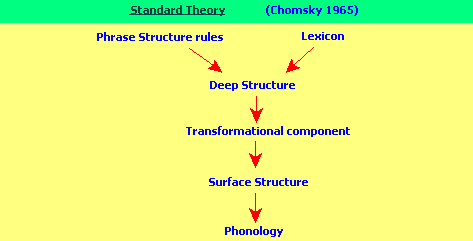 |
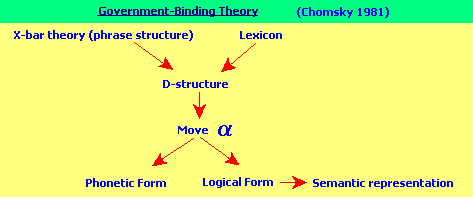 |
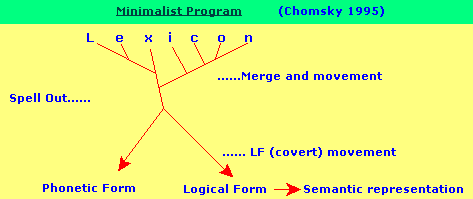 |
3 Noam Chomsky transformational grammar components: Phrase-structure~ Transformational~ Morphophonemic
Every language is said to be trimodal—i.e., structured in three modes: phonology, grammar, and lexicon. These modes are interrelated but have a considerable degree of independence and must be described in their own terms. Phonology and lexicon should not be seen as mere appendages to grammar, the former simply specifying which phonemes can combine to form morphemes (or morphs), and the latter simply listing the morphemes and other meaningful units with a description of their meaning. There are levels of structure in each of the modes, and the units of one level are not necessarily coterminous with those of another. Phonemes, for example, may combine to form syllables and syllables to form phonological words (“phonological word” is defined as the domain of some phonological process such as accentuation, assimilation, or dissimilation), but the morpheme (or morph) will not necessarily consist of an integral number of syllables, still less of a single syllable. Nor will the word as a grammatical unit necessarily coincide with the phonological word. Similarly, the units of lexical analysis, sometimes referred to as lexemes (in one sense of this term), are not necessarily identifiable as single grammatical units, whether as morphemes, words, or phrases. No priority, then, is ascribed to any one of the three modes. Source: "Linguistics." Encyclopædia Britannica Ultimate Reference Suite, 2013. |
If some reader wants to argue that a person can find the pattern they are seeking out, I will agree... at least to a point. For example, if Clausewitzian theory was based on an underlying two-pattern (regardless of how labeled: binomial, dyad, polarity, dual, pair, twin, dichotomy, etc.), we could find examples. But we would end up using a tripartite means of presenting them, such as using a period, question mark or exclamation point in our structured sentences. We might necessarily focus on some "two" aspect such as a double-stranded helix in DNA and RNA instead of its triplet codon (coding) system, but overlook the 3 to 1 formula when we notice that both DNA and RNA have the three same configuration of Adenosine- Cytosine- Guanine with Thymine and Uracil as the respective singular identifiers:
| ~ Item ~ | ~ Three the same ~ | ~ One is different ~ |
| DNA = | Adenosine- Cytosine- Guanine | Thymine |
| RNA = | Uracil |
There are lots of 3 to 1 ratio examples that some perspectives may be labeling them as a four, quaternary, two by two, or other similar compartmentalization. But the point is that all the patterns boil down to the predominant recurring sediment we are itemizing. Necessarily so, we can't reach a pattern-of-three without there being a pattern-of-two or a one. And if a pattern of seven or thirteen or nine million was a predominant recurrence, acknowledged or not, why aren't we doing so? While some have tried to argue that a particular pattern is significant, such as the number seven, then how come we don't find this pattern as a regularity in our language-related exercises of expression? Why aren't there more sentence-ending marks? Why aren't most people holding a pen or pencil with five fingers? Why is a comma used as a point of demarcation between three sets of numbers to indicate groupings related to compartmentalizations of so-called higher orders such as 1,234... 1,234,567... 1,234,567,890., etc.? Why do we divide human pregnancy into three trimesters, and recognize there is a different count when viewing other life forms? Why is life on the third and not 7th planet from the Sun?
If we say that using a "three" pattern, however so named, is a "convenient" tool, why isn't 87 a convenient tool or 5, since it is the number of the typical digits on a hand or foot? Granted we use a binary code in computers, but then why do we apply a three-patterned boolean rule-of-thumb to this? Why not stick with the "2" in multiples thereof? Why are we using the "three" in so many theories and other uses if it is not a survival tool... a tool being utilized by our genetic structure as well? But, there are dozens of similar questions one may ask— all of which lead us back to reviewing the present approach towards an analysis of Clausewitzian triplicity as a response to environmental pressures being placed on humanity's peculiar physiology. It is a physiology that, by the way, can be seen to exhibit a recurrence of the "three" pattern as well:
http://www.lumen.luc.edu/lumen/MedEd/GrossAnatomy/Threes.html The structure of the human body is organized into groups of three with remarkable frequency. I have listed several examples of this tendency by region. This list does not include structures contributing to form the many "triangles" in the body. General 3 layers of skin: Epidermis- Dermis- Hypodermis 3 general venous circulations: Systemic- Pulmonary- Portal Embryology 3 germ layers: Endoderm- Mesoderm- Ectoderm 3 divisions of somites: Sclerotome- Dermatome- Myotome 3 definitive kidneys: Pronephros- Mesonephros- Metanephros 3 derivatives of skull: Desmo/dermatocranium- Splanchno/viscerocranium- Chondrocranium 3 initial embryonic divisions of the brain: Prosencephalon- Mesencephalon- Rhombencephalon Back 3 parts of the erector spinae m.: Iliocostalis- Longissimus- Spinalis (each are divided again into 3 parts) 3 parts of the transversospinalis m.: Semispinalis m.- Multifidus m.- Rotator m. 3 coverings of the spinal cord: Dura mater- Arachnoid- Pia 3 spaces surrounding spinal cord: Epidural- Subdural- Subarachnoid 3 borders of the scapula: Medial (vertebral)- Lateral- Superior 3 angles of the scapula Neck 3 parts of the axillary artery... 3rd part of axillary artery has 3 branches: Subscapular- Anterior humeral circumflex- Posterior humeral circumflex 3 Brachial plexus trunks: Upper- Middle- Lower 3 posterior Brachial plexus divisions 3 anterior Brachial plexus divisions) 3 Brachial plexus cords: (A) Lateral (B) Medial 3 branches off medial cord: Medial brachial- Medial antebrachial- Medial pectoral (C) Posterior 3 branches off posterior cord: Upper subscapular- Lower subscapular- Thoracodorsal 3 branches off the thyrocervical trunk: Transverse cervical- Suprascapular- Inferior thyroid 3 veins drain the thyroid gland:
3 scalene muscles: Anterior- Middle- Posterior 3 muscles attach to spine of C2:
3 constrictor muscles: Superior- Middle- Inferior 3 parts of the pharynx: Nasopharynx- Oropharynx- Laryngeopharynx 3 parts to the hyoid bone: Body- Greater horn- Lesser horn 3 structures inside carotid sheath: Common carotid artery- Internal jugular vein- Vagus nerve 3 ganglia in sympathetic cervical chain: Superior (magnum)- Middle- Inferior (stellate) Head 3 parts of the maxillary artery: Mandibular- Pterygoid- Pterygopalatine 3 divisions of the trigeminal nerve:
3 cranial fossae: Anterior- Middle- Posterior 3 nuchal (nape of the neck) lines: Inferior- Superior- Highest 3 layers to calvarium: Outer table- Diploe- Inner table 3 clinoid processes of the sphenoid bone: Anterior- Middle- Posterior 3 cranial nerves (C.N.) pass through jugular foramen: C.N. IX- C.N. X- C.N. XI 3 cranial nerves (C.N.) travel in the wall of the cavernous sinus: C.N. III- C.N. IV- C.N. V 3 cranial nerves (C.N.) carry parasympathetics to the head: C.N. III- C.N. VII- C.N. IX 3 nasal conchae: Superior- Middle- Inferior 3 principal components of the temporal bone: Squama- Petro/mastoid- Tympanic ring 3 bones of the upper jaw/palate: Premaxilla- Maxilla- Palatine 3 salivary glands: Parotid- Submaxillary- Sublingual 3 muscles innervated by 3 cranial nerves attach to the styloid process:
3 layers in tympanic membrane [eardrum] (derived from 3 germ layers) 3 cranial nerves innervate the external tympanum: C.N. V- C.N. VII- C.N. X 3 middle ear bones: Incus- Malleus- Stapes 3 parts of the ear: Outer- Middle- Inner 3 semicircular canals (of the ear) 3 membranes of the cochlea: Reissner- Tectorial- Basilar 3 intrinsic muscles of the tongue: Longitudinal- Vertical- Transverse 3 muscles elevate the mandible: Masseter m.- Temporalis m.- Medial pterygoid m. 3 branches of the posterior auricular artery:
3 branches of the ophthalmic nerve (VI): Nasociliary n.- Frontal n.- Lacrimal n. 3 superior alveolar nerves:
3 types of deciduous teeth: Incisors- Canine- Molars 3 layers of dentition: Enamal- Dentin- Pulp 3 general layers of the eye: Retinal- Choroidal/ciliary body- Scleral/corneal 3 color receptors in (eye) cone cells: Red- Blue- Yellow 3 nerves to the larynx:
3 cerebral arteries: Anterior- Middle- Posterior 3 arteries supply the cerebellum:
Shoulder 3 muscles attach to coracoid process: Coracobrachialis- Pectoralis minor- Short head of biceps 3 parts of the axillary artery... (3rd part has 3 branches):
3 muscles of the rotator cuff are rotators 3 glenohumeral ligaments: Superior- Middle- Inferior Arm 3 muscles in anterior compartment: Biceps brachii- Coracobrachialis- Brachialis 3 heads of triceps brachii m.: Long- Lateral- Medial 3 muscles attach to greater tubercle of the humerus: Supraspinatus- Infraspinatus- Teres minor 3 parts of the ulnar collateral ligament of the elbow: Anterior- Posterior- Oblique Forearm 3 muscles in deep anterior compartment:
Hand 3 muscles in thenar eminence:
3 muscles in hypothenar compartment:
3 phalanges in fingers: Proximal- Middle- Distal 3 palmer interossei Thorax 3 compartments: Mediastinum- Left pleural cavity- Right pleural cavity 3 branches off the aortic arch:
3 parts of the aorta: Ascending- Arch- Descending 3 principal surfaces of the pleura: Costal- Diaphragmatic- Mediastinal (the cupola is the superior extension) 3 lobes of the right lung: Superior- Middle- Inferior 3 bronchopulmonary segments of the upper right lobe: Apical- Posterior- Anterior 3 muscles of interthoracic wall:
3 false ribs on each side 3 cusps of the semilunar aortic and pulmonary valves of the heart 3 cusps of the tricuspid (heart) valve 3 main arteries of the heart: Circumflex- Anterior interventricular- Right coronary 3 splanchnic nerves: Greater- Lesser- Least Abdomen 3 folds in anterior abdominal wall:
3 muscles contribute to linea semilunaris/rectus abdominus aponeurosis:
3 openings in diaphragm: Aortic- Esophageal- Inferior vena cava 3 arcuate ligaments of diaphragm:
3 parts of the stomach: Fundus- Body- Pylorus 3 smooth muscle layers of the stomach: Oblique- Longitudinal- Circular 3 unpaired branches of the abdominal aorta:
3 branches of Celiac a.: Left gastric a.- Splenic a.- Common hepatic a. 3 branches of common hepatic a.: Right gastric a.- Proper hepatic a.- Gastroduodenal a. 3 arterial branches supply adrenal glands: Inferior phrenic- Aorta- Renal 3 structures lie within porta hepatis: Proper hepatic a.- Portal vein- Common bile duct 3 principal veins contribute to the portal vein:
3 parts of the small intestine: Duodenum- Jejunum- Ileum 3 parts of large intestine: Ascending- Transverse- Descending 3 tenia (band-like structure) of large intestine 3 coverings of the spermatic cord:
3 vessels in the umbilical cord: Umbilical vein and 2 umbilical arteries Pelvis and Perineum 3 bones in os coxae: Pubis- Ilium- Ischium 3 parts of the pubis: Body- Superior ramus- Inferior ramus 3 foramina in the pelvis:
3 gluteus muscles: Gluteus maximus- Gluteus medius- Gluteus minimus 3 rectal arteries:
3 branches of the posterior division of internal iliac artery:
3 openings in the urinary bladder: Left ureter- Right ureter- Urethra 3 parts of the urethra: Prostatic- Membranous- Spongy 3 parts of the uterus: Fundus- Body- Cervix 3 erectile compartments of the penis:
3 muscles in superficial perineal pouch:
3 arteries supply the rectum:
3 valves in the rectum: Superior- Middle- Inferior Gluteus 3 gluteal muscles: Gluteus maximus- Gluteus medius- Gluteus minimus 3 muscles innervated by superior gluteal n.:
Thigh 3 hamstring muscles: Biceps femoris- Semitendinosus- Semimembranosus 3 compartments in the femoral sheath 3 muscular compartments of the thigh: Anterior- Medial- Posterior 3 branches of the lateral femoral circumflex a.:
3 muscles contribute to the pes anserinus: Sartorius- Semitendinosus- Gracilis Leg 3 compartments in the leg... (3 muscles in anterior compartment:)
Foot 3 cuneiform bones: Medial- Intermediate- Lateral 3 phalanges in toes: Proximal- Middle- Distal 3 plantar interossei (related to the sole of the foot) Miscellaneous 3 exams in the course |
Interestingly, however, I did come across a list of twos being used in a psychology course in terms of polarities, which presents us with an example of a perspective that either does not see a third option or uses one but does not portray it as an expressed component of consideration. In other words, a third item is silently being used by the viewer... even if they act out a type of compromise, middle ground, fulcrum, modifier, buffer, etc., without it being explicitly labeled. I will follow the list with two others that offer additional "twos" examples as a means of stating the obvious that patterns-of-two exist in a variety of instances:
HISTORY AND SYSTEMS OF PSYCHOLOGY, DR. WARREN R. STREET |
|
(J. E. Bogen)
| Left Hemisphere | Right Hemisphere |
| Intellect | Intuition |
| Convergent | Divergent |
| Digital | Analogic |
| Secondary | Primary |
| Abstract | Concrete |
| Directed | Free |
| Propositional | Imaginative |
| Analytic | Relational |
| Lineal | Non-lineal |
| Rational | Intuitive |
| Sequential | Multiple |
| Analytic | Holistic |
| Objective | Subjective |
| Successive | Simultaneous |
(I Ching)
| Yin | Yang |
|---|---|
| Feminine | Masculine |
| Negative | Positive |
| Moon | Sun |
| Darkness | Light |
| Yielding | Aggressive |
| Left side | Right side |
| Warm | Cold |
| Autumn | Spring |
| Winter | Summer |
| Unconscious | Conscious |
| Right brain | Left brain |
| Emotion | Reason |
The presence of ideas involving dualities, is an interesting one because many view such a structure as being unbalanced... therefore needing an additional one... as either a means of developing a complete whole in terms of diplomacy or as a means of controlling a natural inclination towards pairing up (as in the idea of opposites attracting) so as to be able to instigate division in order to split the dichotomy into an oppositional formula for some ulterior reason (other than an harmonious fusion). For example, the idea of Yin and Yang as a duality expressing a natural pairing that is mutually beneficial (in a given environment), can be contrasted with the idea of a paired right/wrong situation. One duality is non-oppositional though named opposites are identified, and the other duality is viewed as opposites needing a third inter- mediary meant to mold or at least restrain explosive forms of interaction... like a controlled burning of available fuel as opposed to letting nature take its course in the sense of unrestrained interactions (that must nonetheless conform to the type and quantity of available inflammable materials).
Though we can cite a third entity in the Yin/Yang complement... called "Unity", it, as a third element, is merely referential and is not to imply a separate element such as a child being born. It is like splitting an atom and giving the released energy the same status as the atom itself, thereby being an "unseen" attribute that can only be witnessed if the harmony is split up by division. Whereas one may think they have caused the birth of a new entity, to unveil a statue hidden in a chunk of marble or granite— so to speak; what they have done is at least make us aware of a consciousness that is seeking an identity by creating contention... and yet is not defined as a phenomena, an entity, or even a thing unto itself, which is trying to communicate its (their) presence through the acts they can perpetrate by producing events by way of creating or controlling various dualities. In a sense, the third element is like a spirit or ghost that is trying to communicate but is as yet unable to express itself in the manner we are accustomed to, and must therefore find some substitute which is at present confined to a placement of itself as a third element in a duality. But perhaps a better way to describe the situation would be to ask the reader how they would try to communicate? Would they rely on motion picture presentations about ghosts and their efforts to communicate with the living, or devise some other means of communicating? For example, some "ghosts" communicate by possessing another's body for a short period, while others are enabled to create static in electrical devices. Others are allowed to distort magnetic fields or atomic matter, and still others rattle chains.
Granted there are some readers who would prefer to discuss Clausewitzian theory from a gamesters point of view, like a person entrenched in the jargon and labels set into particular contexts which evoke a sense of being a type of sporting event where the personality and talents of players as well as coaches is part of an "in depth" understanding of game strategy; their understanding will remain superficial unless they have a grasp of Trichotomy as a type of thinking sometimes employed as a strategy itself. Without a written record of how often earlier hominids thought, in terms of what we might consider to be related to a singularity, duality or triplicity, we can nonetheless identify that a usage of a "three" sense has followed a usage of a "two" sense later on in history. For example, the old testament of the Bible apparently indicates more of a usage of duality, in contrast to the New Testament which describes numerous patterns-of-three in the life of Jesus:
| Three
Wise Men came to me with three gifts, on Christmas morn they had followed a star to see the Saviour-king who was newly born And when I was a young child exploring the world as a child plays I got lost for three days but within a home of God, I smiled A spirit led me into the wilderness to be three times tempted by the Devil Satan wanted to make me one of his but I gave visiting angels my soul I taught so that all might remember- "to Ask, to Seek and to Knock" for with these keys, all things surrender and Heaven's doors unlock I was 3 times ten plus 3 years old speaking out for Faith, Hope & Charity some thought me evil, others called me bold but what I did, I did for thee "I am not," was all that Peter would say when asked if he is one of my disciples his third denial came after I was led away, before the moment a cock crows Many think I dropped the cross three times on the way to my crucifixion and with two others found guilty of crimes, that 3 of us had embarked towards Heaven It is believed that three nails were used to bind each hand and both feet - my executioners expected to be abused but with words like these I chose to speak: "And though my flesh deeply pangs for water while blood also trickles from each hand, please forgive them oh Father for they do not understand" It was Pilate who inscribed above my head, in Greek, Latin and Hebrew, on a wooden plaque that could be read: 'Jesus the Nazarene the King of every Jew' When at 3 o'clock, I was to take my leave so that future generations might believe, some say I said this simple phrase of three: with a sponge soaked in sour wine but others around said "Let him be!", to see if God would save me in time It was on the third day that I rose after having been crucified and every kind-hearted person knows, it was for each of you that I died Three women with spices sweet, came to soothe their hearts by anointing me but I had gone before them, to Galilee for it is there we were to meet To my disciples behind shut doors, I came twice to be heard then near the sea of the Tiberieas shores, meant this visit was my third I asked Simon Peter three questions knowing he would answer the same my undying love was given in these lessons, so that all the future might gain All authority in Heaven and on Earth had been given to me on the day, that I had known since my birth I would be ascending with yet much to say but, so that all nations might realize hoping all peoples would come to hear it my disciples were sent out to baptize, "in the name of the Father, Son & Holy Spirit" Like a thief in the night, I am to come unto you though some believe this untrue, I pray your heart shines my light Tis not a mystical coincidence that my life's story has patterns-of-three you must come to know of its significance as my love for you has not forsaken thee. |
It's not that we can't find examples of "threes" in the New Testament, it's because we find a dominant usage of this value in such an important character's life seems to suggest a developmental changing in the cognitive pattern during the time of the Bible's development into a written form. It may go hand in hand with a concomitant development in mathematics and other intellectual inquiries in terms of brain development. The representation of different "threes" formulas occurring in different subjects being pursued at the time in the manner they were, are examples of ghostly images pertaining to a developing psyche. The "threes" are a mental version of "hearing a voice", like the presumed voices of gods heard by those whose brains were undergoing maturational development and needed a socially acceptable means of placing the voices into an understandable context... and what better way than to describe one's "voices" as the comments or commands of one or more gods. It didn't matter if the "voices" were in bits and pieces, constant or sporadic, internally or externally directed in occurrence; one either had to think negatively about oneself and entertain the notion of insanity, or think in positive terms such as being a "chosen" one to receive one or another god's "message"... that undoubtedly was suffused with cognitive impressions derived from different sources such as memory, impulse, external persuasion, motivation, etc...
The perceived dualities in the past were actual entities sometimes portrayed in the form of a god or demon. They were personified, just as a third element becomes personified in the event it can instigate between/amongst a duality. If it creates the "presence" of escalated conflict, it becomes more real itself. Yet, all in all, it is the reflection of the developmental trend of a biological organism subjected to a changing environment, despite all the intellectualisms applied or how complicated one attempts to play out different scenarios as if playing intellectual chess with oneself or others. Triadic structures, just like dualities once were, are the expressed impressions of our brain undergoing a developmental response to a changing environment where a pattern-of-three event occurred before biological life began, during its adaptive changes, and is causing a fusion because the three-patterned environmental influence is fusing.
The "three" is an image of a change in our brain. This is why there are so many different versions of the "three" occurring according to the application of one's energies at a given task in a given social environment. The "three" is a fore-shadow of an eventual fusion to occur. The delay in responsiveness to the environmental three suggests the biological nature of humans is reactive but not reflexive. However, those who are deemed as "sensitively receptive" people, may have an earlier recognition of environmental events that will become more prominent and effect many others; may therefore think or act strangely accordingly, because they are ahead of their time, so to speak. If the whole of society became susceptible to subtle environmental impressions because the "sensory hide" of humans became more sensitive in some overnight fashion; there might be cataclysmic changes in human society creating a chaos, because not everyone might obtain the same level of sensitivity nor interpret the same perceptions in the same way, simultaneously. Severe social disconnects might well occur creating conflicts and misunderstandings on multiple levels. Lives would be dramatically changed.
For example, let us imagine everyone waking up tomorrow morning with a 200 I.Q. focused primarily on the game of tiddlywinks. Everyone's life would migrate towards a culture focused on the analysis, playing and enterprise of the game. All subjects would be directed towards improving the game, with all former interests being supplanted. Religion, history, mathematics, anthropology, industry and the like, would all be used to resource the importance of everyone participating in a "tiddlywink" culture. All forms of communication would be directed towards a discussion about tiddlywinks, and those who would do otherwise would be shunned, imprisoned or executed for their rebelliousness. Since all things and ideas would be focused on the game, all perceived dualities would be viewed as a harmony of complements because they are fit into the same mold or interaction. Rebelliousness would be the introduction of a third, disharmonious element in an otherwise duality of participation. The participation of everyone in the game is the observed sanity. Those who do otherwise may be tolerated, in so much as they are not perceived as a threat and perhaps even as a means of supporting those who want a reason to participate... non-participators have a more difficult time in sociability. But if one is deemed a threat to the observed philosophy of the group, they might be viewed as having something wrong with them... and need to be labeled as such by way of creating circumstances which will assist the society in making a determination to remove the individual(s) from being a bad influence.
The rebellious person thus becomes a personified image of a third entity being formed in the human mind by way of an unrecognized developmental trend due to changing environmental circumstances. They, as a more sensitive person than the larger social group, are disposed to responding to the changes they are undergoing... though there may be no social context or observed idea which is readily available for usage. The situation becomes more difficult if their experiences waver between the old and new impressions, such as between a perception of duality and triplicity, making their new-found impressions all the more difficult to find a means of expression. Such individuals may turn to distractions or punishment in an attempt to keep them from either experiencing the impressions or trying to express them in an acceptable medium... though conventionalized creative exercises may not be adequate... even if they permit oneself an excuse by calling the expressions the product of a "creative license". The usage of a "three" formula today is different than it was in the past, where a dominant "two" orientation was apparently used to categorize perceptions. Dualities seen as complimentary pairings is different than dualities being perceived as polarities. Seeing them as complements instead of polarities indicates a difference in a brain development where a third item has been born to find a means to express itself from its present dimension of existence related to an environmentally-based influence.
Whereas one might want to argue that a theory of warfare such as is being presented in the Clausewitzian idea would be better if it utilized a pattern-of-two formula because our brain has two hemispheres, it is necessary for us to look at the different attributes of the two hemispheres, even if in some distant future time the list might be viewed as a superficiality just as we of the present sometimes do with past ideas:
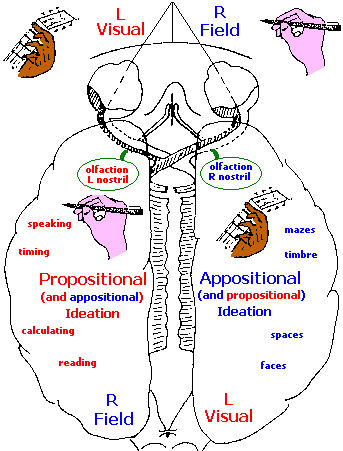 |
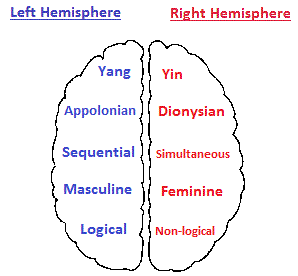 |
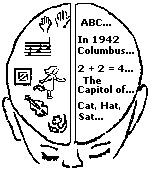 |
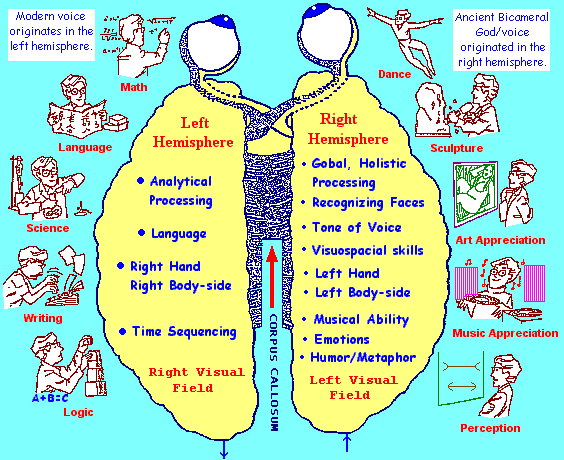
***Note: Much of the brain illustration shown above was adapted from page 106 of Dean Falk's book entitled "Brain Dance," 1992.
When we look at the assigned culturally recognized attributes of the brain, we can see a distinct (over-lapping) 1-patterned, or 2-patterned, or 3-patterned arrangement. (Reminder: when a person gets a stroke in the left hemisphere of the brain it affects the right side of the body, and vice-versa.)
|
Left Hemisphere (Predominantly 3-patterned) Math: Associative Commutative Distributive Logic: Major Premise Minor Premise Conclusion Time Sequencing: Seconds ~ Minutes ~ Hours Past ~ Present ~ Future Day ~ Week ~ Month Language: Subject Object Verb Right Body Side: Tri-cuspid heart valve Three-lobed lung |
Right Hemisphere (Predominantly 2-patterned) Holistic: Macro versus Micro Whole versus Part Inner versus Outer Music: Major Scale vs Minor Scale Loud versus Soft (Quiet) Consonance vs Dissonance Visuospatial: (Art) Background vs Foreground Light vs Dark (Contrasts) 1 Dimension vs 2 Dimensions Emotions: Pain versus Pleasure Positive vs Negative Love versus Hate Left Body Side: Bi-cuspid heart valve Two-lobed lung |
 The correlations of two and three being made on this page are not typical considerations. However, I did come across a single reference concerning the tricuspid valve: http://www.madsci.org/posts/archives/mar97/855255174.An.r.html | |
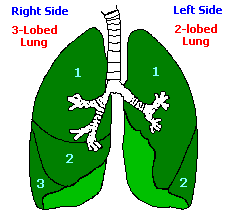 In recognizing that the left lung is smaller than the right lung (which provides room for the heart), let us conjecture that this is due to some past earlier developmental sequence just as we find the 1-layer, 2-layer, 3-layer sequential development of the 3 primordial germ layers (Ectoderm - Mesoderm - Endoderm) in primitive -to- more complex organisms. Hence, difference in size (dimorphism) as well as a two/ or three prominence may provide another link towards understanding developmental processes. Does this mean that the recurring smallness of the female to the male in many species indicates that females came before the male in terms of species-specific evolutionary development during particular environmental circumstances? If so, will there be an increased development towards a 3 to 1 "fusion" ratio? | |
|
(Reptilian) (Predominantly 1-Patterned) (Self)-Preservation~ (Self)-Procreation~ (Self)-Preeminence | |
Some additional two-patterned references found in music:
- Tension and Release
- Staccato and Legato
- Slow and Fast
- Ascending and Descending
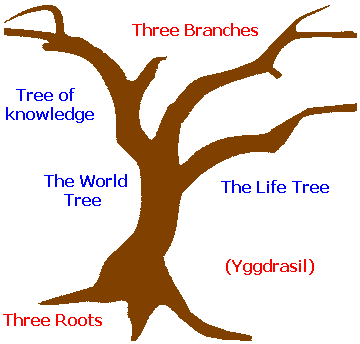
An imaginative analogy to the 3 brain divisions of:
Reptilian ~ Neo(New)-Mammalian ~ Old Mammalian
or: (Reptilian - Limbic system - Neo-cortex)...
Can be made with the ancient view of the world once held by Nordic peoples who thought the three roots and three limbs of the Yggdrasil tree held Earth, Hell, and Heaven together. (A 3 into 1 fusion concept.)
When we look at Clausewitzian theory, just like the very many other ideas utilizing some pattern-of-three structuring, that is if we don't get caught up in the minutiae of internalized details; we may come to a point where we wonder why we are using such a pattern...? Is it because such a pattern actually exists in the material under scrutiny; is it merely a generalization for intellectual convenience because we secretly think most people can't conceptualize at a higher quantization; or has something predisposed us towards such a utilization? Does living on the 3rd planet from the Sun make such an influence? The three-patterned ear ensemble? Or perhaps the triplet coding in our genetics? Then again, what may have influenced such a recurring pattern to appear in our physiology?
If it is not because there exist patterns-of-three in physics (electrons- neutrons- protons), three quarks, three anti-quarks, three families of fundamental particles, etc., because such ideas have also been occasioned by the same influence; what then could have influenced the development of a "three" pattern in our genetics and physiology? Is our physiology merely a type of three-patterned vibrational replication of the triplet coding in DNA and RNA, or is the idea of a triplet coding system a representative echo thereof as well? I mean, do such threes patterns actually occur, or do we only think they do because we are environmentally duped into exhibiting such a pattern both physiologically and psychologically? What then is it?
Let us assume that the "threes" development is not linked to some extra-terrestrial, and that which initiated the "threes echo" still exists today in a form we can recognize. At present, all I can see is the effective role of the Sun. This requires that we acknowledge that the Sun is expanding towards its burnout, the Earth's Rotation was much faster in the past (and thus is subsequently slowing), and that the Moon is receding:
- Sun is enlarging and may engulf inner-most three planets.
- Earth is slowing, altering geo-magnetic field.
- Moon is receding, affecting tidal behavior.
The early Sun during the billions-of-years-ago theater debut of our earliest biological beginnings might well have exposed (impressionable) biological development to a three-patterned stroboscopic irradiation effect, involving the three "moments" of the Sun known as Dawn- Noon- Dusk, each having their own representative distinct influential characteristics mirrored in both plant and animal behavior. The strobe-light effect would have occurred when the Earth rotated faster, producing a sort of irradiated (heated) centrifuging effect... where different pools of biological materials would have been like separate, but similar test-tubes.
Since we are talking about hearing and sight, with the other senses kept in mind close-by, let us view the occurrences of irradiation forms from the perspective of waves or vibrations... which are patterns... and patterns can be called circadian rhythms or biological time. Yes, time. Where as the old sundials had one hand, later clocks had two hands and still later clocks had three hands (sometimes replaced by digital readouts), let us merely mention the analogy that our three-patterned theories may be a means of marking out a particular biological time that we neither know how to accurately recognize or interpret. Our repetitious use of "three" in different subject areas may be a type of marker, where a point of demarcation is going to occur like a comma in a counting sequence. Or perhaps more easily understood as one of the three (translation-termination) signals called stop codons.
The wide-spread usage of "threes" is giving us an indication of a biological relatedness in a given (planetary) environmental setting, which is changing. In other words, as the Sun continues to expand, the Earth continues to slow down, and the Moon continues to recede; these three events will have an effect on our biology. The three-patterned strobe-light effect is being altered by an accompanying "fusion" of the three solar "moments" as "seen" by our affected biology.
By using time-elapsed photography, we come to acknowledge that the Sun's pattern is not linear (across the sky); is not circular (over the sky); but is triangular. The following image is of the Moon in eclipse, though the picture could just as easily be of the Sun. I inverted the picture in order to show the complete pathway of ascent (up) and descent (down). This is a picture taken from page 80 of the 10/97 issue of Natural History magazine showing a time-elapsed image of the Moon during a daily trek:
Though we need time-elapsed photography to see the image, what if our bodies can "see" it biologically, like some plants orienting themselves to the Sun? Though we can recognize that some plants "see" the Sun and express themselves by behavior consistent with the biology of the plant in question, it is uncertain whether plants can acknowledge their own perception of such. Likewise, how many environmental events do we humans "see", but can make mention of them through the acts of crude responses, such as the development of triadic theories? Triadic theories might thus be a type of helio-trophism (movement towards or because of the Sun), if this is in fact the originating cause for "triadic brain movements" called ideas or theories. The difference in our biologies, diets, social circumstances, etc., effects our level of responsiveness (high/low, deep/superficial, short duration/long duration, etc...)— and the type according to one's inclined application:
- Religion: Trinity, (3 great monotheisic religions), Brahma- Vishnu- Siva, etc...
- Sociology: Upper - Middle- Lower classes, 3 branches of government, Communism- Sociology- Democracy, etc...
- Military organization: Army- Air Force- Navy (included Marines), etc...
- Biology: Triple Coded genetics, triplet Microtubules, AMP- ADP- ATP, etc...
- Horse Racing: Trifecta, Win- Place- Show, 3 ancestors to stud book entrants, etc...
- Music: 3-patterned "hook" in popular songs, musical triads, etc...)
But such triadic structures are occurring by way of left hemisphere activity, whose attributes are three-based, and is part of the New mammalian brain. The old mammal brain, if and when it has been dominantly exercised, has a preference to "see" (and even express) the world in groups of two... dualities that may be complimentary or oppositional. The left hemisphere can see a "three" organization in a formerly viewed two-pattern, and may even set itself up as either an oppositional or complement. Yet, the two and three patterns are but images representing how our biology is responding to two and three-based environmental events. These are going to be supplanted by a fusion that may be expressed by ratios such as three to one, three in one, three and one, three out of one, etc., patterns, or derivatives thereof, including inversions such as one out of three, one from three, etc... Different ideas involving this pattern will no doubt be used and variously applied by their adherents with supportive rationales. All of them are referring to biological adaptations due to changing environmental events which require the usage of related (cognitive) survival skills... even though the skills are self-defeating because the overall environment is headed towards a decay.
You will have to envision a slowing Earth's rotation coupled with a receding Moon and an enlarging Sun. The three "moments" of the Sun are continuing to "fuse" as the Sun's presence engulfs the sky. The effects of the three "moments" detailed in different ways by different life forms and their individual biologies will continue to be effected and expressed accordingly. The environment of the Earth will likewise change accordingly. Although the following simple image is of the enlarging Sun gobbling up the Earth in seconds, the event will take place over billions of years, even though no one is yet certain how far the Sun will actually expand. Nonetheless, it is occurring now and is affecting us now. There is no guarantee that more and more people will not become more sensitive to its effects as we proceed into the future. Awareness increases sensitivity as well as can create misinterpretations along with varying methods to decrease the effects. The image is seen from the perspective of someone at a distance from the Earth. The effects would be quite different if you were on the Earth looking towards the Sun.
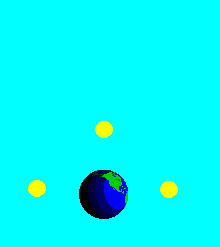
No one should get caught up in any Three-based formula, however it is called or applied, without acknowledging the possibility that it is little more than a variably selective projected representation of an environmental event impressing itself on our biology, which others may also manifest; thus developing into a type of species with environmental specific characteristics (in their claws, teeth, dermal covering, breathing, eyesight acuity or diminishment, etc...). In other words, those who adopt a particular "threes" (or whatever) ideology, become a part of a species using this as a type of cognitive survival mechanism. If physics is the domain they mark their niche of territory, or religion, or law, or military strategy, or governing practice, or musical genre, etc., whether they are cognizant of using one or more three-patterned mental, physical or emotional attributes or not... within a given cultural setting and adopted language... these same people may be unaware that their perspective is being shaped along a continuum of decay as an accommodation to the planet's trek of deterioration.
Such ideas, regardless of language, regardless of parallel alignments used as a means of justifying the appropriateness of usage based on a presumed historical precedent; are all temporary survival mechanisms, even if one measures "temporary" in terms of hundreds, thousands or millions of years. Gradual or punctual deterioration is still deterioration that can go unnoticed and become rationalized as being natural, and therefore appropriately needed and supported by trite expressions such as "that's life", "you can't argue with nature", "laws of nature", etc... All the concepts, all the lifestyles which are accordingly molded by such views; particularly defended by those socially viewed as leaders who may preach that God and the Universe have designed existence to preserve life, are in fact incrementally leading the populations of Earth along a path of self-destruction because their ideologies reflect supportive rationalizations for thinking they are on some selectively "chosen" path they are destined to follow but that are little more than transitional transformations anti-thetical to biological life.
If humanity can not get past its variable array of self-absorbing schematized strategies, regardless of the basic pattern being used in the observed theory, ideology, perspective, or whatever you wish to entitle it; there may be a point at which humanity is truly stuck in the mud and spinning its wheels, more so than the present social structures are doing with all the exercised silly life-styles placed into self-honored positions of notability. The survival of the species rests on those that can get the world's populations to apply all their resources towards getting the species off the planet, away from this solar system,and eventually away from this galaxy. It is a social project that will dwarf any and all those which were used in the past such as the building of the pyramids. If the past is any indication of human cognitive development, humanity may witness the rise and fall of many other civilizations because adaptive survival mechanisms (in terms of ideas), deteriorate over time and become replaced by ideas more consistent with what effects are being impressed on the species by the decaying environment.
Humanity's recurring usage of three-based orientations and expressions, though most of them are unrecognized as occurrences, have taken place along a one-two-three maturational development whose earlier conditions may no longer exist or are hard to distinguish, particularly in the case where a new arrival does not appear to show any resemblance to a former structure. Mutations in ideas occur just as they do in biological structures, though instances of an earlier scaffolding are indistinct and/or occur at great distances, times, and during events which appear to be totally unrelated if they are recorded at all. And though we may want to claim a particular influence of later ideas to be that of some recognized perspective, such as a religious trinity having influenced poetry, limmericks, literature, movies, paintings, architecture, experimentation, relationships, etc., its own influence of origination might be argued to be due to the triplet coding in DNA and RNA. Yet, then we have to consider all of them as having had a discernible originating source that has nothing to do with religion or biology... because the multiplicity of threes (and other patterns) in these and other subject areas presents us with a Darwinian type of development with respect to ideas... that our ideas are types of species with a fundamental code of their own which indicates a similarly basic environmental influence... that is heading along a course of decay.
Increasing populations create a condition in which the fusion of ideas occur by way of effective proximity to incur influential exchange, whether the individual(s) are consciously aware of such or not. Perceptions begin to identify similarities and different ideas are seen as being the same, albeit clothed with different cultural garments. In other words, basic patterns are recognized and accepted as natural occurrences. People see the same forces of nature though they may label them with names consistent with the language and experiences of one's culture. For example, the ancient Greeks saw the Seas and Earthquakes as a god and called them by the name of Poseidon, while the ancient Romans used the name Neptune in referring to the forces of the Sea. Anything and everything could be named a god, though not everything was. Like animals, only a few were "domesticated" into the human hearth, not to mention only a few types of grains for consumption. There was a limit. This limitation refers to our cognitive ability related to the state of our biology and brain development under given circumstances. While we think the people in the past had the same type of body and brain, we might find differences (1) if we were able to examine them side by side, (2) if we had the means for such a dissection, and (3) the ideological framework to carry out such an analysis.
The fact of limitation is particularly overlooked because there is no frequent context in which the limitation can be addressed to make a point applicable for reviewing a larger subject area without resorting to generalizations which do not enable a specificity of application. Similarly, though there are multiple subject areas for study, they are subsumed under a parent heading which are themselves collated by being indexed under the heading of Education or some other such singular referencing rubric meant as a generalized specificity, like the label of God which, considered to be an offshoot of human ego, was used to portray the idea of a single God (a projection of self-importance), and hence a single religion (such as Judaism), as the supreme God corresponding to a supreme religion corresponding to a supreme, or "chosen" people. The One God idea came to supplant ideas involving multiple gods that referenced different perceptions of environmental and human event that humans were trying to not only grasp, but have some measure of control. It was the expression of a fusion of a "Many" gods idea.
Though we of today have large numbers to work with, there is a limit to how many we actually use. Throughout the day for many people, the idea of quantity may not be enumerated at all. Instead, we may refer to as a group with the label "lots", "numerous", "multiple", "many", "few", "some", "bunch" or some such reference. Instead of saying "three", we might say "few" or "some", though we and others we are speaking with understand the quantity to be three. While we may obtain more than three items, those after the quantity of "three" may be viewed as extra or superfluous... the loss of which has no bearing on what we had focused on in terms of an unspoken desired limit. The occurrence of limitations in our thinking has been recognized by those involved in the research of number development. Though the concept of zero is a separate but related issue, let us note that early humans used a very simple counting system when they began to relate quantity to a number and number to a related number word.
It has been discovered that counting sequences developed along a "one- two- many" script, with each number occasioned with a stoppage or limitation. For example, in one's own language equivalent way, the word "one" for the quantity of "1" was established, but there was no "2" which immediately followed. In a sense, a cognitive limit had been reached for a time. Then came a word such as "two" to indicate the quantity "2", followed by another cessation of further cognitive application. According to multiple researchers, it appears that there was a multi-cultural usage of the three number words "one- two- many". Any quantity beyond "2" was considered "many", but this observation of three words is not typically placed into the context of people today using "three-based" ideas in a similar fashion. In other words, a trinitarian perspective, regardless of subject area, is a repetition of this same early cognitive pattern that may itself be a repetition of some earlier usage that was not recorded because it took place during a time when people did not write, did not think to keep a record, nor were even aware of their specific awareness. The repetition of a threes usage with words in different ideas is like having put a comma after 123, and was continued by using ABC, that may no doubt be continued by some other symbols, sounds, ideas or events. It's like saying small, medium and large, and then continuing by repeating the last reference by applying additional symbols: X-large, XX-large, XXX-large. The "three" is being repeated in different ideas.
We can mix and match any symbols and associated ideas, along with images, that we want, but the basic pattern remains the same. It remains the same because we do not need to alter it for survival... though survival is only temporary so long as we remain on this planet. Its usage is an adaptation to an influential environmental occurrence, that one may describe as a compensatory activity... as in the case of a blind person acquiring more acute hearing or in some other perceptual sense. Some people will dream in threes, others will think in them, and still others will organize their life in threes, such as one may focus themselves on an exercise regime of three days, walking three miles, eating three specific meals, etc... The environment does not require us to think beyond the "three" because this is the lesson being taught to us. Hence, our physics, our geology, our writing and all other skills merely become compounded representations of the same underlying pattern as a reflection, an imitation of a three-patterned environmental event that is heading towards a fusion. Clausewitzian theory utilizing a tripartite organizational framework is like other theories using there own three-based formulas. They are reverberations, echos, and reflections of an ongoing environmental event that exists in our genetic code as well. But all of it is subject to change...
Entry: 1-23-16 (Saturday)... Though I have mentioned it prior to the writing of this page, it should be noted that if humanity brings themselves to participated in a mass exodus from Earth; there will be the need for creating an artificial (space craft) environment for not only sustaining life, but for sustaining the integrity of the triplet bio-molecular trio of DNA-RNA-Proteins, with a particular emphasis for replicating the environmental event which promotes the recurrence of the triple pattern in DNA and RNA... not to mention the three start and three stop codons. I reiterate this point as a precursor to a page to be written on Artificial Intelligence, after one is written on the (Vitaly) Efimov trimers discussed in a Quantu magazine article by Natalie Wolchover entitled "Physicists prove surprising rule of threes". Comments from a 3sological perspective need to be raised about the findings because of the existing notion that if we are environmentally influenced towards a "Threesological" interpretation; this may suggest there is an increased incidence of being effected by the environmental influence. In other words, the finding of Efimov trimers does not necessarily say they exist or don't exist, but is a remark more about our changing cognitive state.
Page Originated: Monday, January 18, 2016
Initial Posting: Wednesday, January 20, 2016... 01:49 PM
Updated Posting: Saturday, January 23, 2016... 11:13 AM
Herb O. Buckland
herbobuckland@hotmail.com